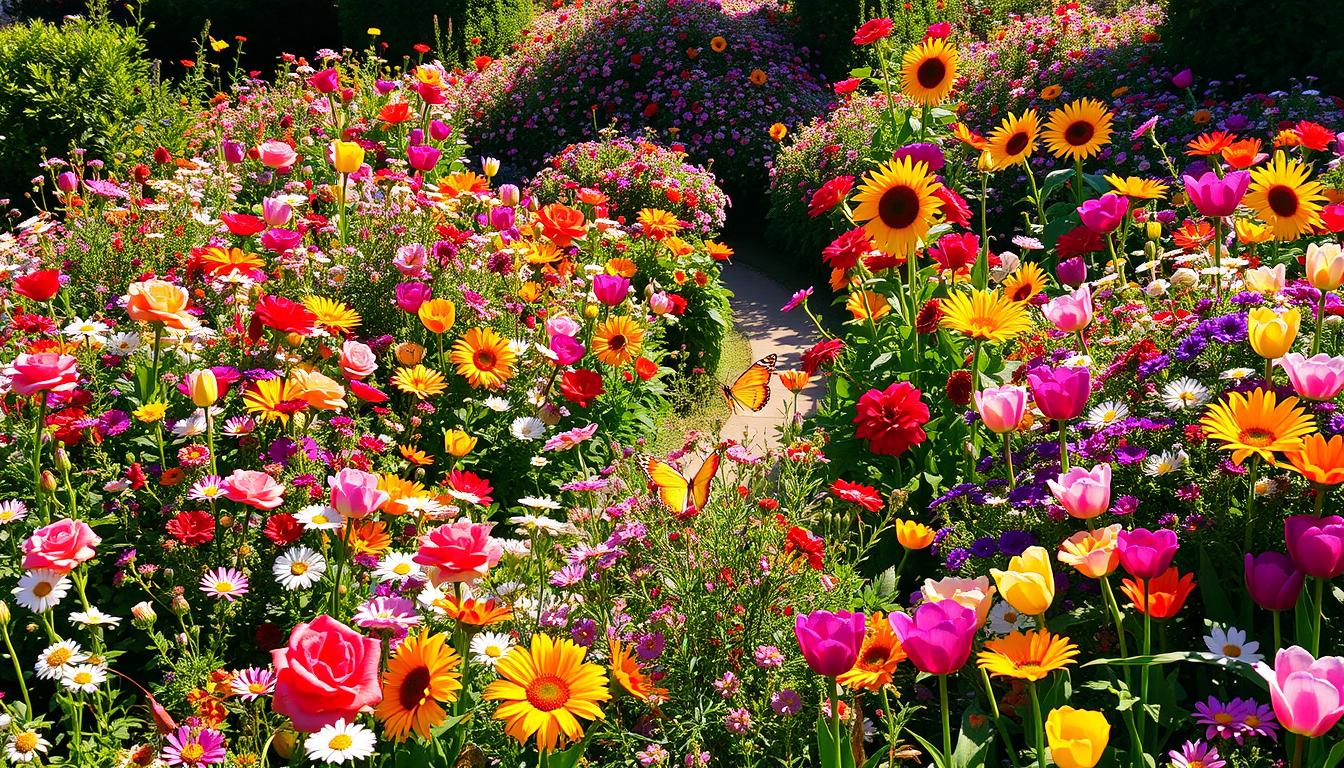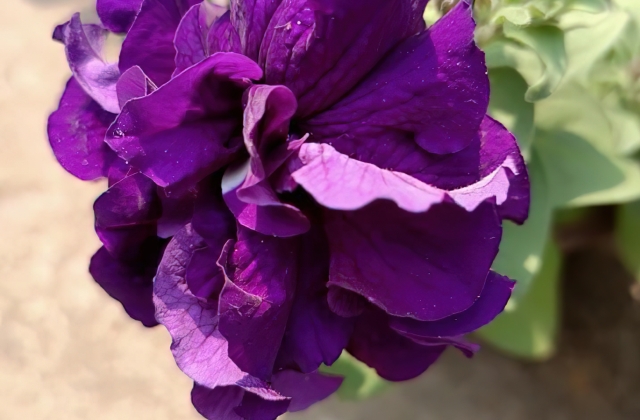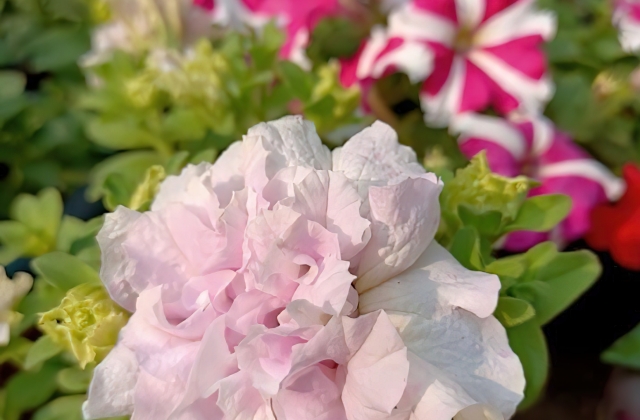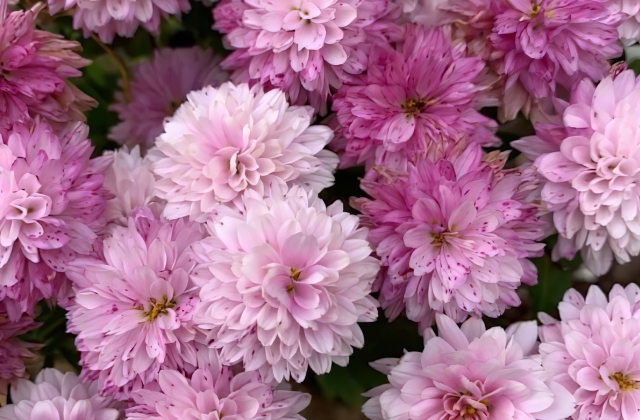Create Your Dream Flower Garden: Tips & Inspiration

Turning your outdoor area into a lively and lovely flower garden is a fulfilling project. Start with a clear idea, check your garden’s potential, and pick the right plants for your area. This way, you can make a beautiful spot that shows off your style and offers a peaceful, nature-rich escape. These tips and ideas will help you make your dream flower garden, whether you’re an expert or just starting.
Key Takeaways
- Carefully consider your garden’s sun exposure, soil health, and water accessibility to select the best plants.
- Incorporate a variety of flower types, colors, and textures for a visually stunning garden design.
- Utilize hardscape elements, water features, and sustainable practices to enhance your garden’s functionality and appeal.
- Design your garden layout with strategic placement of taller plants and easy-access pathways.
- Select a mix of perennial and annual flowers to enjoy blooms throughout the seasons.
Unleash Your Inner Gardener
Gardening is more than just a hobby; it opens a door to joy, relaxation, and personal growth. It doesn’t matter if you’re an expert or just starting out. Gardening can turn your outdoor area into a peaceful and beautiful spot.
Embracing the Joys of Gardening
Gardening connects you deeply with nature. Taking care of your plants, watching them grow, and enjoying their colors and textures brings peace and a sense of achievement. It helps you step away from daily stress and dive into a calming, meditative world.
Cultivating a Personal Oasis
Creating your own garden is very fulfilling. By picking the right plants and designing the space, you can make an outdoor area that shows your style. Gardening as a hobby lets you build a garden retreat. This place is for relaxation, a source of gardening benefits, and reflects your personal taste.
“Gardening is a kind of disease. It infects you, you cannot escape it. When you go visiting, your eyes rove about the garden; you interrupt the serious cocktail drinking because of an irresistible impulse to get up and pull a weed.”
– Lewis Gannett
Gardening offers many rewards, like the joy of caring for plants, the beauty of their colors and textures, or the pleasure of making a lovely outdoor living space. By diving into this hobby, you open up a world of fulfillment. You can create a garden retreat that feeds your mind, body, and spirit.
Planning Your Garden Oasis
Starting a beautiful flower garden begins with planning. First, imagine your dream garden. Think about the colors, textures, and atmosphere you want. Consider the plants, layout, and special features you’ll need.
Visualizing Your Garden Dreams
Begin by sketching your ideas or looking at garden designs. Picture the plants, flowers, and materials you want. Think about the mood you want, like a calm oasis or a bright display.
Assessing Your Outdoor Space
After envisioning your garden, check your outdoor space. Look at its size, shape, and features. Consider the sun, soil, and any challenges or benefits your yard has. This helps you plan the best garden layout and design.
| Factors to Consider | Key Insights |
|---|---|
| Yard Size and Shape | Understand your yard’s dimensions to plan your garden. Irregular yards need creative designs. |
| Sun Exposure | Check how much sun your yard gets to pick the right plants. |
| Existing Landscape Features | Notice any trees, shrubs, or structures that affect your design. You can include or work around them for a unified look. |
| Soil Conditions | Check your soil’s quality to pick the best plants for it. |
| Privacy and Screening Needs | Think about how plants, fences, or other elements can make your garden private and personal. |
By planning your garden and understanding your space, you’re ready to make a beautiful flower garden. It will show off your style and preferences.
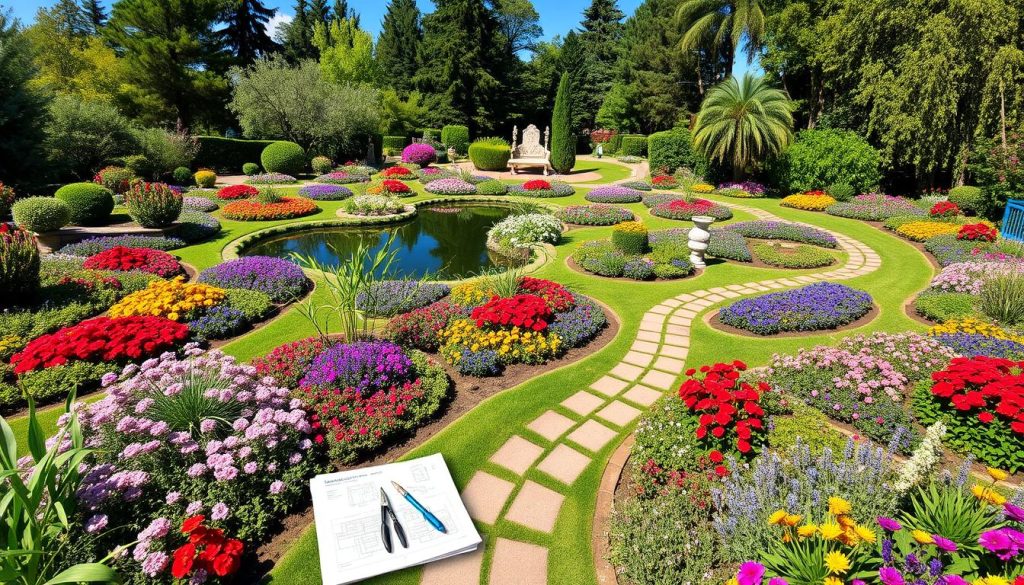
Selecting the Ideal Plants
Starting a flower garden means picking the right plants for your area. Think about the climate, light, water, and soil you have. Choosing plants that fit your climate means they’ll grow well and need less care.
Choosing Plants for Your Climate
Look for plants that are native to your area for a garden that’s easy to care for. These plants usually need fewer pesticides and less water. Also, think about how big each plant will get to make sure they have enough room.
Exploring Color and Texture Combinations
Try out different plants to make your garden more interesting. Mix plants with different colors, shapes, and textures for a beautiful look. Use odd numbers of flowers for a better layout. Put taller plants in the back and shorter ones in the front for depth.
| Plant Characteristic | Consideration |
|---|---|
| Hardiness Zone | Select plants that can thrive in your local climate |
| Light Availability | Full-sun perennials require at least 6 hours of direct sunlight |
| Water Needs | Incorporate drought-tolerant and water-loving plants |
| Soil Type | Amend soil as needed to provide optimal growing conditions |
| Plant Size | Consider the ultimate height and spread of each plant |
By picking a mix of flower garden plants, you can make a garden that looks great and fits your style. Try out different plant combinations to find what works best for you.
Crafting Functional Spaces
Designing your flower garden is more than making it look good. It’s about making it useful and practical too. Think about adding things that make your garden better for everyday use.
Seating areas are a must. Put benches, chairs, or cozy sets in the right spots to make your garden a place to relax. These spots let you enjoy your flowers and relax, read, or chat with friends.
Paths are also key in a garden. Well-placed walkways help people move around and keep things tidy. You can use stone, gravel, or pavers for the paths to match your garden’s look.
| Garden Feature | Functionality | Aesthetic Impact |
|---|---|---|
| Seating Areas | Provide comfortable spots for relaxation, socializing, and enjoying the garden | Can enhance the overall ambiance and create inviting gathering spaces |
| Pathways | Guide visitors through the garden, create a sense of order and flow | Can complement the garden’s design and add visual interest |
| Designated Activity Zones | Allocate specific areas for dining, entertaining, or gardening tasks | Help define the garden’s overall layout and purpose |
Think about adding special areas for different activities in your garden. You could have spots for eating, having fun, or working in the garden. Planning your garden well makes it a great place to live outside, blending beauty with practicality.
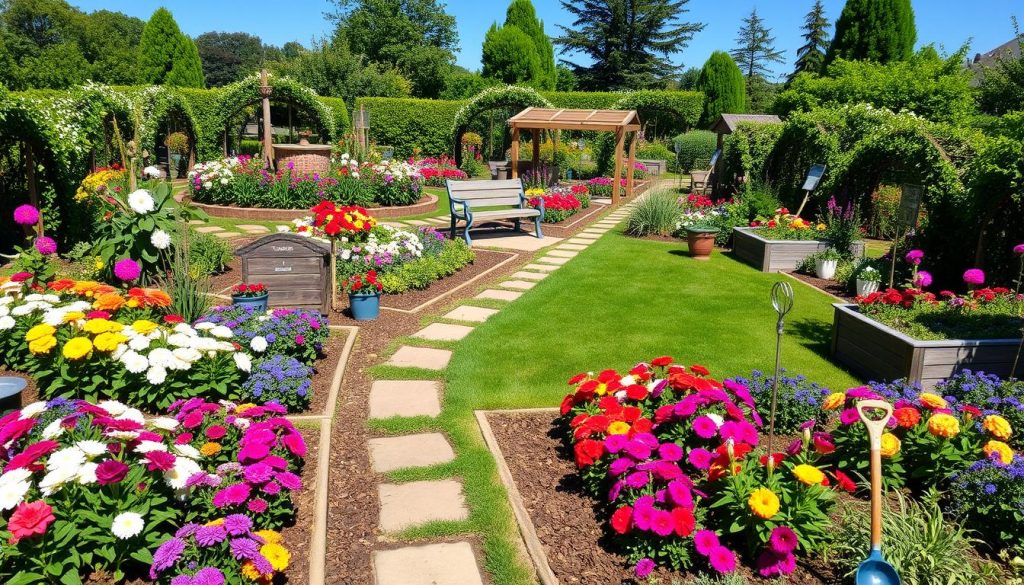
“The true essence of a garden lies in its ability to provide a haven of tranquility and functionality, where the beauty of nature is seamlessly woven with practical elements that enhance our outdoor living experience.”
Incorporating Hardscape Elements
Make your flower garden look better and work better with hardscape elements. These include pathways, patios, and garden features. They turn your outdoor area into a perfect mix of beauty and use.
Pathways and Patios
Pathways and patios add beauty and are useful for walking, eating, or chilling. Use natural stone, brick, or gravel for walkways that lead through your garden. Patio areas are great for hanging out with friends and family, letting you enjoy your garden’s beauty.
Garden Structures
Garden structures like arbors, pergolas, or gazebos can be the stars of your garden. They offer shade, look great, and give you a cool spot to relax. These features can also support vines or show off your favorite plants, blending hardscape and softscape beautifully.
| Hardscape Element | Benefits |
|---|---|
| Pathways | – Add visual interest – Provide practical walking spaces – Guide visitors through the garden |
| Patios | – Create designated outdoor living areas – Enhance the overall aesthetic – Facilitate outdoor entertaining |
| Garden Structures | – Serve as focal points – Provide shade and architectural interest – Support climbing plants |
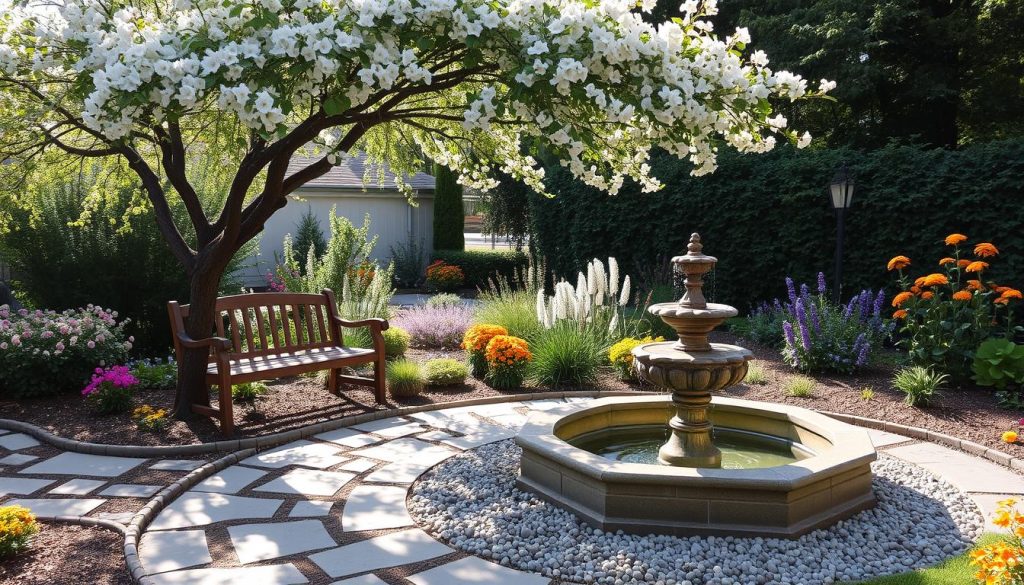
“Hardscape and softscape elements work together to create a harmonious and visually appealing outdoor space.”
Enhancing with Water Features
Adding water elements to your flower garden makes it peaceful and calm. It turns your outdoor space into a peaceful retreat. Fountains and ponds are great for this, adding beauty and benefits to your garden.
A fountain is a great choice for any garden. You can find them in stone, metal, or even old tea pots. Putting one near where you sit or along a path makes your garden more relaxing. It also makes a beautiful centerpiece.
For bigger gardens, a garden pond is amazing. It can be full of plants and maybe even fish. A pond makes your garden feel like a peaceful oasis. Add plants like hostas around it for a natural look.
For a modern garden, think about a water wall or a water feature that bubbles. These add a modern touch and the sound of water. They make your garden feel fresh and new.
When picking a water feature, think about your garden’s size, your budget, and how much upkeep you can handle. With some planning, these garden water features can be the highlight of your garden. They make your garden a peaceful place to escape.
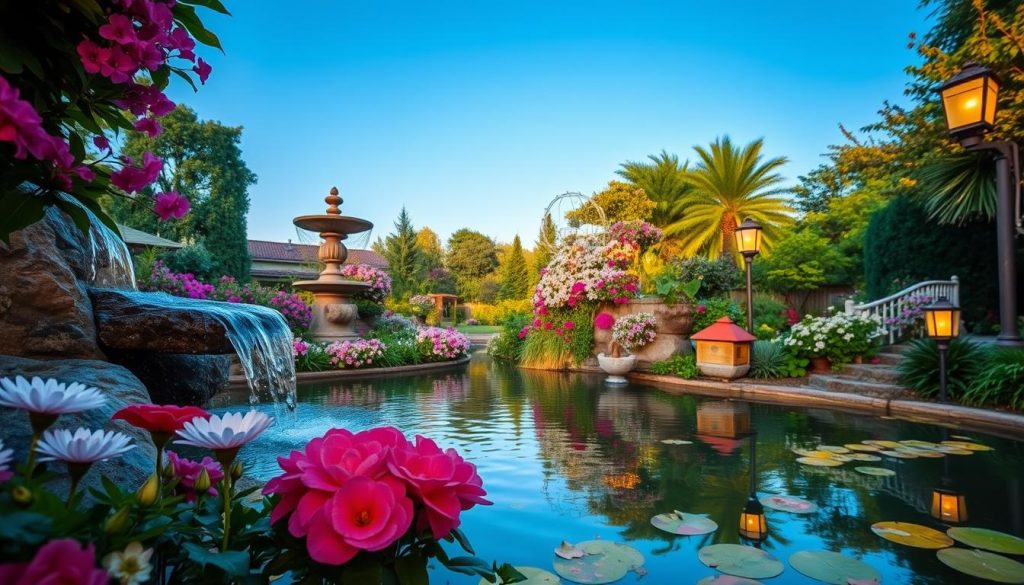
“The sound of water is the most beautiful music in the world.” – Lao Tzu
Embracing Sustainable Practices
Gardeners can make their gardens beautiful and good for the planet. By using sustainable gardening, we can enjoy our gardens and help the planet. Let’s look at ways to save water and garden in an eco-friendly way for a sustainable garden.
Water Conservation Techniques
Water is very important for our gardens. To save water, try drip irrigation or soaker hoses. These methods lose less water than sprinklers. Using rain barrels or cisterns for rainwater can also help with watering.
Place your watering devices smartly to stop water from running off into storm drains.
Eco-Friendly Gardening Methods
- Choose plants that need less water to live, which cuts down on water use.
- Make compost from yard waste to create rich soil for your plants.
- Use hand weeding or organic pest control instead of chemical sprays.
- Think about using electric or push mowers, which are better for the planet.
- Add sustainable materials like FSC-certified wood or permeable pavers to your garden.
By using these sustainable gardening tips, you can have a beautiful garden that’s easy to take care of. It will also match your values for the environment. Let your garden show the beauty of caring for the planet.
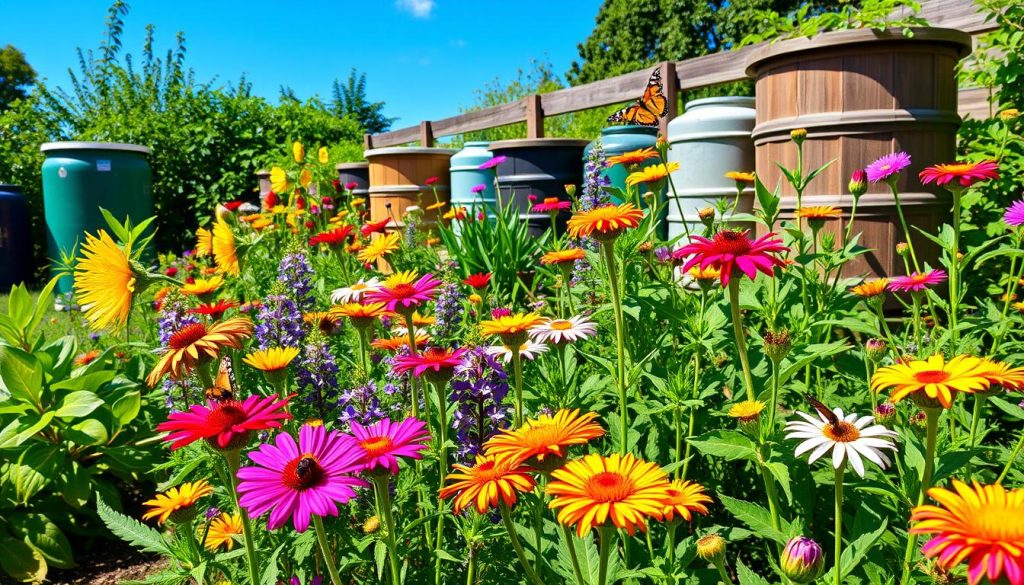
Defining Your Garden Style
When planning your flower garden, it’s key to define your personal garden style. Garden style is the look and feel you aim for in your outdoor area. It shows your unique vision and tastes. You can get inspiration from garden design magazines, online, or even nearby gardens.
Do you like a formal, modern, or playful garden theme? Adding elements that match your garden inspiration will make your garden look great. Think about your home’s style, your garden’s size, and the plants that do well in your area. These can help guide your garden style choices.
A formal garden might have symmetrical beds and a central feature like a fountain. An informal garden could have winding paths and colorful plants. Trying out different garden design ideas can help you find the personal garden aesthetic you like best.
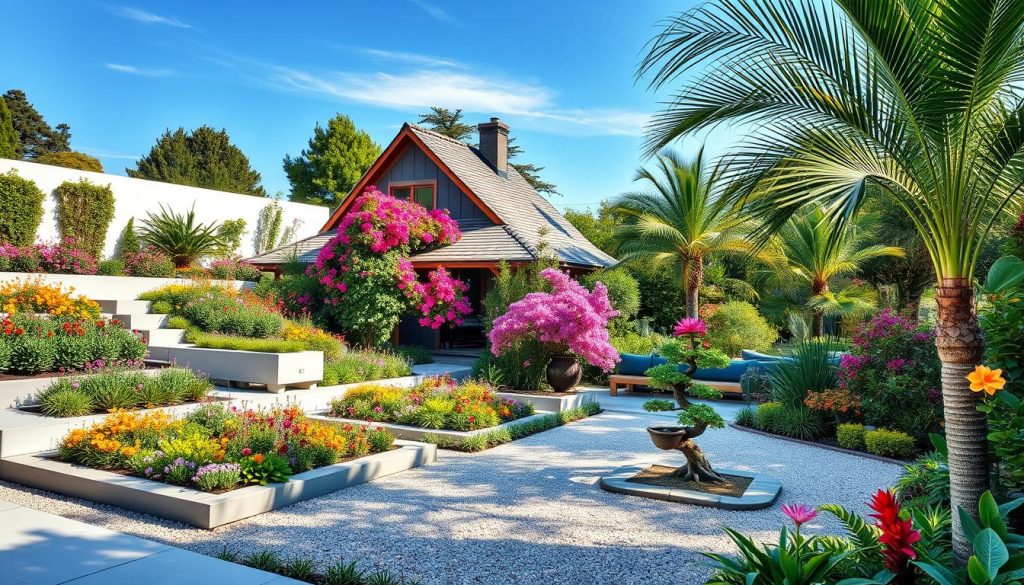
Your flower garden shows off your home and personal style. By picking your garden style, you make a special outdoor space. It should make you happy and improve your property’s look. Let your garden inspiration lead you in making a garden that shows off your personal garden aesthetic.
flower garden
The heart of your dream garden is in the flower beds and arrangements you make. Choose a mix of flowering plants that bloom at different times and have various colors and growth habits. This mix will keep your flower garden looking great all season. Try out different flower garden layouts and patterns to get the look you want, whether it’s a classic English garden or something modern.
Look at flower garden ideas to make your own special place. Use a blend of annuals, perennials, and flowering plants for flowers all season. Play with colors, like one color or many, to make your flower garden design stand out.
A flower garden is beautiful not just for its flowers but how it’s put together. Add paths, garden features, and water to make your flower garden look better. Try out different flower garden types, like formal or wild, and show off your creativity.
| Flower Garden Inspiration | Key Features |
|---|---|
| English Cottage Garden | Abundant, informal plantings; mix of annuals and perennials; romantic, whimsical aesthetic |
| Contemporary Geometric Garden | Clean lines, bold shapes, and striking color contrasts; often feature modern hardscaping |
| Pollinator-Friendly Garden | Diverse selection of native plants that attract butterflies, bees, and other beneficial insects |
With planning and creativity, you can turn your yard into a beautiful flower garden. It will show off your style and be a peaceful spot for you to relax.
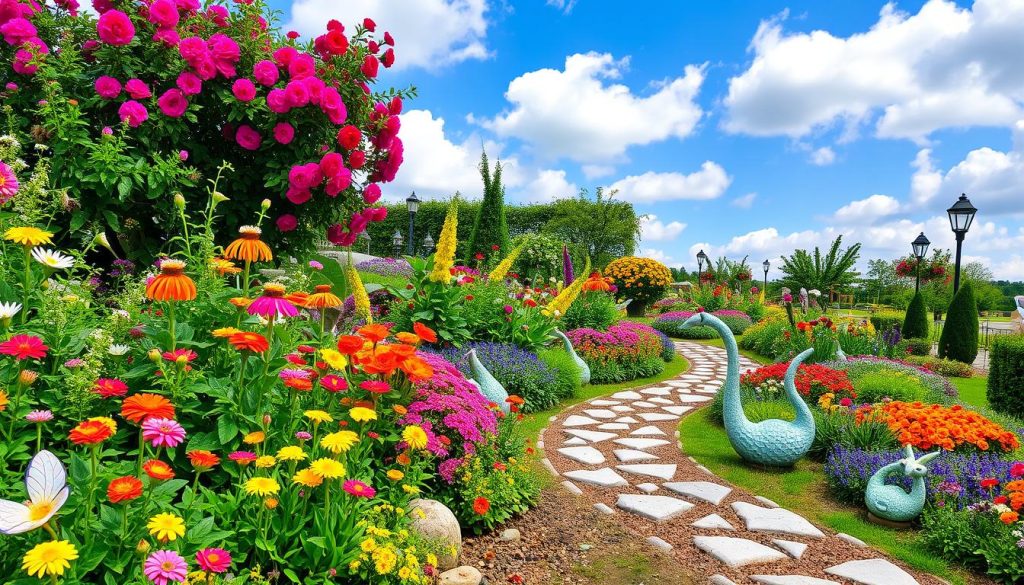
“A garden is a grand teacher. It teaches patience and careful watchfulness; it teaches industry and thrift; above all it teaches entire trust.” – Gertrude Jekyll
Gardening Tools and Accessories
Having the right tools and accessories for your flower garden can make gardening better and more productive. Essential items and decorative pieces can help your garden look great and thrive. Quality products are key to a beautiful outdoor space.
Essential Gardening Tools
Make sure your gardening toolkit has these must-haves:
- Pruners: A good pair of anvil or bypass pruners makes cutting stems and branches easy.
- Trowel: A strong hand trowel is essential for planting, moving plants, and working with soil.
- Garden Hose: A durable garden hose makes watering your plants simple.
- Watering Can: Use a watering can with your hose for gentle watering of small plants.
Also, think about getting gloves, loppers, garden forks, shovels, rakes, hoes, and watering wands. These tools help with various gardening tasks efficiently and comfortably.
Garden Decor and Accessories
Add beauty to your garden with decorative items and accessories. Things like colorful planters and fun garden sculptures can make your garden a personal retreat.
| Product | Regular Price | Sale Price |
|---|---|---|
| Ultimate Leather Garden Tool Belt & Holder | $129.99 | $129.99 |
| Garden Dibber (Dibble) for Seeds | $11.49 | $11.49 |
Keep your gardening tools and accessories in good shape to make them last longer and work better. Sharpen blades, clean and oil parts, and store them right to keep them in great condition.
Creating a Low-Maintenance Oasis
Creating a beautiful flower garden that’s easy to maintain is possible for busy people. By using sustainable gardening and picking the right plants, you can make a garden that looks great all year. Let’s look at how to make a low-maintenance gardening space.
Choosing plants that are tough and can handle drought is key to an easy-care flower garden. Plants native to your area or similar climates are great because they fit right in. These plants need less water, food, and care for pests.
Using sustainable garden design ideas helps make gardening easier. Things like deep mulching, big plant beds, and gravel paths cut down on upkeep. These methods keep the soil moist, stop weeds, and make walking through the garden easy.
| Sustainable Gardening Practices | Benefits |
|---|---|
| Incorporating native plants | Reduced need for watering and pest control |
| Deep mulching with compost and manure | Moisture conservation and weed suppression |
| Wide plant beds and gravel paths | Easier maintenance and accessibility |
| Composting and soil improvement | Healthier plants and reduced fertilizer needs |
With these low-maintenance gardening tips, you can turn your yard into a lively, easy-care flower garden. Discover the secrets of sustainable garden design and enjoy a time-saving gardening oasis.
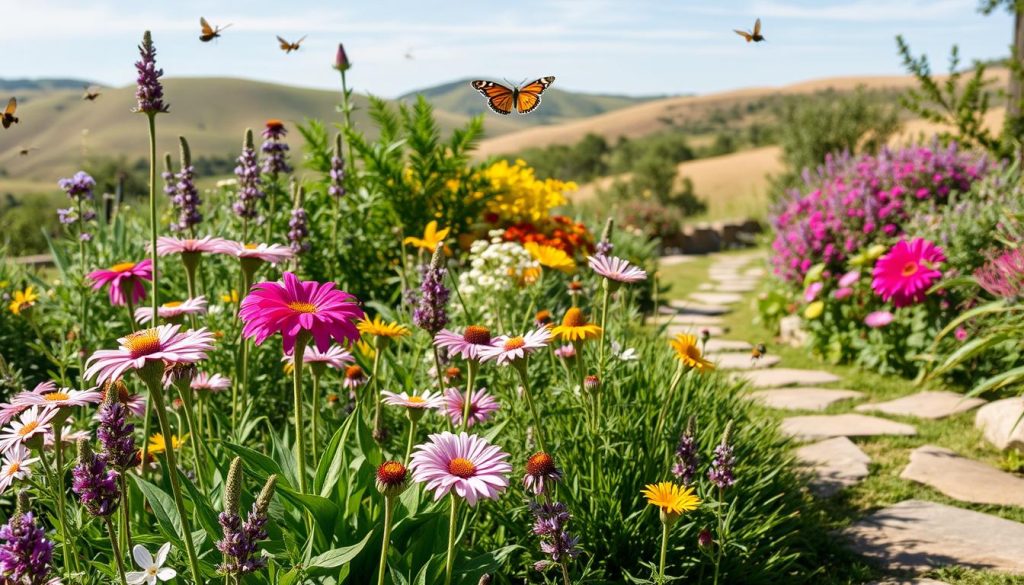
Nurturing Your Garden’s Growth
Keeping your flower garden healthy and bright needs regular care. By following seasonal maintenance routines and tackling problems early, your garden will stay vibrant.
Seasonal Maintenance Routines
Adjust your garden maintenance with the seasons. In spring, prune, deadhead, and fertilize to help new growth. Summer is for watering and watching for pests or diseases.
As fall comes, clean up and mulch to get your garden ready for winter.
Troubleshooting Garden Problems
Be prepared to fix garden troubleshooting issues like pests or diseases. Know the common pests and their signs. Have a plan to deal with them quickly.
Watch out for drought or too much heat, and find ways to protect your plant health.
By being proactive and flexible in your garden care, your flower garden will keep thriving. It will bring you beauty and joy all year round.
| Seasonal Gardening Task | Spring | Summer | Fall |
|---|---|---|---|
| Pruning | ✓ | ||
| Deadheading | ✓ | ✓ | |
| Fertilizing | ✓ | ||
| Watering | ✓ | ✓ | |
| Pest/Disease Monitoring | ✓ | ✓ | ✓ |
| Debris Cleanup | ✓ | ||
| Mulching | ✓ |
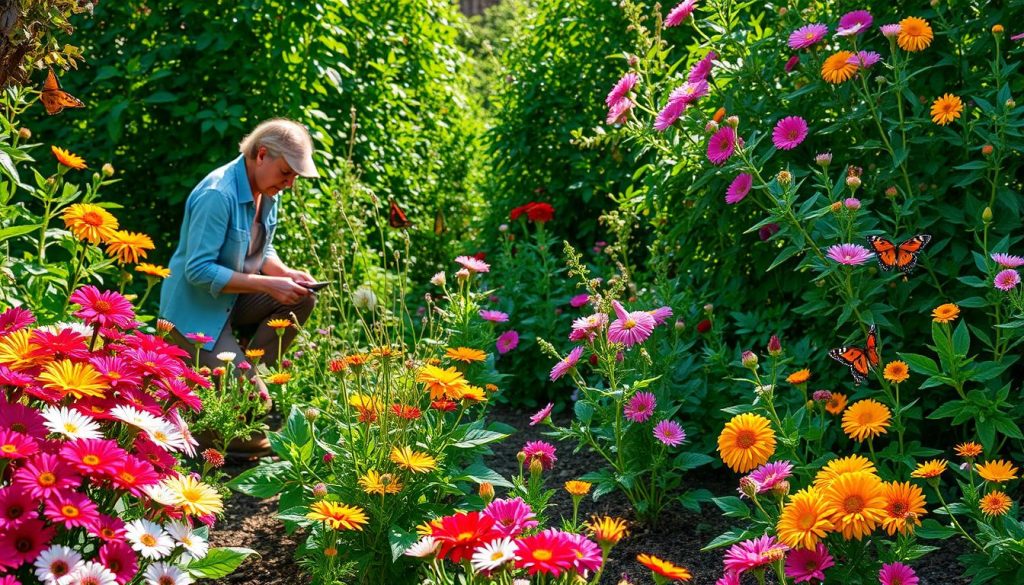
Conclusion
Creating your dream flower garden is a journey full of planning, planting, and care. It’s about making a vibrant and personal outdoor space. By picking the right plants and adding both beauty and function, you can make your yard a peaceful retreat.
With the right care, your garden will keep growing and changing. It will bring you beauty, relaxation, and a connection to nature.
Gardening is great for your mind and body. It lowers stress, anxiety, and depression. It also helps lower blood pressure and reduce heart disease risk.
Flowers help bees and butterflies, which are vital for plants and nature. They also clean the air by taking in carbon dioxide and making oxygen. This makes the air cleaner and healthier.
Whether you’re new to gardening or have been doing it for years, you can make your dream garden. Use the tips and ideas from this article to create a space that shows your style and welcomes wildlife. Let gardening change your life and make your garden a peaceful place full of beauty and nature.
